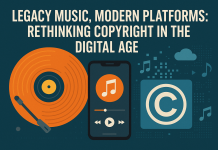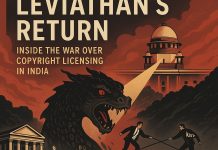In the much-awaited decision which would have had a tremendous precedential value determining the scope of fair use exceptions of use of music in wedding ceremonies under Section 52(1)(za), the matter has been withdrawn by PPL in view of an amicable settlement arrived at between the plaintiff Phonographic Performance Limited (PPL) and Lookpart Exhibitions and Events Private Limited. Read order here.
As covered in detail in our post here, PPL had filed a copyright infringement and injunction suit against the Defendant for use of sound recordings in which the Plaintiff has rights, at various social events managed and organised by the Defendant on regular basis without obtaining license for such exploitation from the Plaintiff. The Defendant had placed reliance on Section 52(1)(za) of the Copyright Act, 1957 and submitted that the music is played for the purpose of marriage ceremonies and other social events connected with marriages, therefore there is no requirement of obtaining license from PPL. Considering the large scale impact that this issue would have had, the Hon’ble Delhi High Court had vide order dated 11th May, 2022 appointed an expert, Dr. Arul George Scaria under Rule 31 of the Delhi High Court Intellectual Property Division Rules, 2021.
The report submitted by Dr. Arul George Scaria can be accessed here.
The summary of the submissions of Dr. Scaria which has been reproduced in the order as well is as under:
“7. The current international legal instruments on intellectual property, particularly the Berne Convention for the Protection of Literary and Artistic Works, 1886 (“Berne Convention”), the Agreement on Trade-related Aspects of Intellectual Property Rights, 1995 (“TRIPS Agreement”), WIPO Copyright Treaty (“WCT”) and WIPO Performances and Phonograms Treaty (“WPPT”) provide sufficient flexibilities for the member states to provide exceptions and limitations that are fine-tuned to the local social, economic, cultural and legal requirements. The Indian copyright law has made use of the flexibilities available within the international copyright law framework, striking a fair balance between fostering incentives for creativity and ensuring adequate access to copyrighted works for the society through the various exceptions and limitations provided under the Act. S. 52(1)(za) of the Act is one such exception, which comes within the scope of ‘implied exceptions’/ ‘minor exceptions’/‘minor reservations’ allowed under the international treaties on copyright law. As per the TRIPS Agreement, the member states are required to submit their laws to the TRIPS Council to ensure that the provisions are in compliance with the TRIPS Agreement. India has submitted her copyright laws and no objections have been raised by any of the Member States on S. 52(1)(za). This may also be viewed as an affirmation that the Member States of the WTO agree that this provision is in compliance with the Berne Convention and the TRIPS Agreement.
8. S. 52(1)(za), including the explanation provided therein, warrants a broad reading in view of the legislative intention as well as the Indian socio, economic, legal and cultural context. The following specific aspects may be taken into consideration by the Court while adjudicating the scope of S. 52(1)(za). First, marriage is one of the most important social institutions in India and marriage ceremonies as well as the related festivities are given the highest importance by most communities in India. S. 52(1)(za) needs to be interpreted in a manner that protects and promotes the important constitutional right under Article 21 of the Constitution to perform marriage and engage in marriage related festivities in accordance with one’s own tradition and culture. Second, the existence of criminal remedies for copyright infringement, combined with the fact that copyright owners are not required to go through any formal examination system to claim copyright ownership over any subject matter, makes it important to limit the scope of rights of copyright owners in the context of official and religious ceremonies, and more specifically ceremonies and festivities associated with marriages. As copyright infringement is also now interpreted by the Supreme Court as a cognisable and non-bailable offence under S. 63 of the Act, a narrow reading of the provision may lead to potential harassment by police officers and copyright owners during one or more of the important ceremonies or festivities associated with marriage. Third, potential police intervention during marriage or any social festivities associated with marriage is also a potential threat to the right to privacy guaranteed under the Constitution.
9. As is evident from diverse case-laws and scholarly literature from different jurisdictions including India and the United States, the engagement of a facilitator who empowers a copyright user to exercise their legitimate user rights under copyright law or the commercial character of that facilitating entity, should not prevent the Court from allowing the exercise of a right provided under copyright law. In the absence of facilitators, most users in India may not be able to exercise their legitimate rights under S. 52(1)(za).
10. The Court may also examine whether the invitees to a marriage can be considered as “public” under the Act for the purpose of analysing whether there is a violation of right of public performance or right of communication to the public. While the Indian copyright statute does not define the term ‘public’, relevant case-laws suggest that ‘public’ has to be understood in accordance with the ‘character of the audience’. In the specific context of marriages in India, invitees are generally limited to those from family and social circles of the partners in the marriage. Hence, there may not be a violation of the right of public performance or right to communicate to the public.
11. Finally, a balanced copyright system necessitates drawing a delicate balance between the rights granted to copyright owners through exclusive rights and the rights provided to the society/ users of copyrighted works through limitations and exceptions. The social, cultural, historical, and legal context of S. 52(1)(za) warrants a balanced interpretation of the provision to ensure protection and promotion of social benefits.”
Judicial precedents:
In the case of Phonographic Performance v. State of Punjab[i], the Hon’ble Punjab and Haryana High Court held that reproducing a sound recording without a license from the copyright society in any event (including a marriage ceremony) would be a copyright violation. In this case, the Petitioner prayed for quashing an order issued by the Additional Director of Police in 2011. The order directed the District Police Chiefs to cross-check facts before lodging cases against disc jockeys (DJs) at the instance of PPL (the petitioner). PPL argued that such an order was liable to be struck down as it interfered with the rights granted to it under Section 34(1) of the Act. According to the Petitioner, it had the sole right to authorise the communication of sound recordings to the public. The question therein was whether the performance of musical works by DJs in marriage ceremonies was exempted or license had to be taken for performance of sound recordings in such marriage ceremonies. The Court held that “It would make no difference, even if it were to take place in a religious ceremony. A sound reproduction by a DJ performing at such an event is surely a function that is connected to marriage. It is not as if a DJ’s performance amounts to conducting the marriage. Marriage is definitely different from the functions connected to the marriage and the tariff regime applies to performances at such functions even if it has a religious overtone”.
In the case of Devendra Kumar Ramchandra Dwivedi v. State of Gujarat and Ors.[ii], as per the Hon’ble Gujarat High Court, the main thrust of Section 52(1) of the Copyright Act, 1957 is to exempt live performances of such creations since there is no commercial objective, no admission charge, and/or admission proceeds are used solely for academic, religious, or charity reasons and not for private monetary benefit. The fair or honest usage doctrine is the most important limitation on a copyright owner’s exclusive rights:
“The Central Government State Government or any local authority can arrange the performance of a literary, dramatic or musical work, officially which will not amount to infringement of copyright or also in connection with a bonafide religious ceremony like Navratri Pooja, Arati, etc. so also marriage procession or other social festivities associated with a marriage, would not amount to infringement of copyright.”
In Novex Communications Private Limited v. Union of India & Anr[iii], the Punjab and Haryana High Court struck down a public notice issued by the Copyright Office dated 27th August 2019 The public notice had tried to clarify that as per S. 52(1)(za) of the Act, “utilization of any sound recording in the course of religious ceremony including a marriage processing and other social festivities associated with a marriage does not amount to infringement of copyrights and hence no license is required to be obtained for the said purpose”. However, the High Court struck down the public notice and held that the executive had no power under the Act to “clarify or interpret applicability of law in the manner suggested in the impugned public notice/letter” . The Court observed that the issuance of such public notice also violated the doctrine of separation of powers as “an attempt has been made by Respondent no. 2 (the Copyright Office) to usurp the legislative power of enactment and judicial power of interpretation”. In addition, according to the Court the public notice also infringed the right of the copyright holder under Articles 13, 14 and Articles 19(1)(g) of the Constitution of India. The Court, following the decision in PPL case (supra), observed that the Act empowered the petitioner to make use of S. 63 to 70 of the Act to enforce its rights, and “there can be no doubt that the petitioner-Company is entitled to enforce the rights secured under the Act through both mechanism like civil law as well as by setting criminal law in motion” .
Dr. Scaria’s report lays down a list of some 66 countries which have provisions similar to Section 52(1)(za) of the Copyright Act. It would have been interesting to see the judgement of Delhi High Court on this issue after taking into account the submissions of Dr. Scaria’s report which emphasizes that a balanced copyright system necessitates drawing a delicate balance between the rights granted to copyright owners through exclusive rights and the rights provided to the society/ users of copyrighted works through limitations and exceptions. However, in view of the amicable settlement between the parties, the Delhi High Court could not decide this case on merits. Dr. Scaria’s report would certainly have persuasive value on future litigations on this issue.
[i] Civil Writ Petition No.7772 of 2011 (O&M).
[ii] MANU/GJ/0440/2009.
[iii] CWP No. 28758 of 2019 (O&M).
















![DELHI HIGH COURT RULES IN FAVOUR OF T SERIES & SAREGAMA IN COPYRIGHT INFRINGEMENT CASE AGAINST RADIO BROADCASTERS FOR VIOLATION OF RULE 29 OF COPYRIGHT RULES [READ JUDGEMENT]](https://iprmentlaw.com/wp-content/uploads/2021/11/artworks-000021426043-5d76ou-t500x500-100x70.jpeg)
